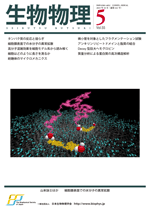All issues

Volume 55, Issue 5
Issue 321
Displaying 1-15 of 15 articles from this issue
- |<
- <
- 1
- >
- >|
Perspective
-
Takuo YASUNAGA2015Volume 55Issue 5 Pages 231
Published: 2015
Released on J-STAGE: September 29, 2015
JOURNAL FREE ACCESSDownload PDF (137K)
Overview
-
Kunisato KUROI, Masahide TERAZIMA2015Volume 55Issue 5 Pages 235-241
Published: 2015
Released on J-STAGE: September 29, 2015
JOURNAL FREE ACCESSBiological molecules fluctuate at room temperature in solution, because of the thermal motion. A relationship between fluctuations and biological reactions should be clarified for understanding molecular mechanism of biological reactions. Some methods to detect protein fluctuations are reviewed. In particular, a recently developed time-resolved method to measure the fluctuations based on the transient grating is described. This method was applied to a reaction of a blue-light sensor protein TePixD. This result clearly demonstrated that the compressibility, which reflects the fluctuation is enhanced during the reaction. It was also found that this enhanced fluctuation is a trigger of the reaction, supporting the importance of fluctuations for the biological function.View full abstractDownload PDF (1351K)
Review
-
Eiji YAMAMOTO, Takuma AKIMOTO, Kenji YASUOKA2015Volume 55Issue 5 Pages 242-245
Published: 2015
Released on J-STAGE: September 29, 2015
JOURNAL FREE ACCESSDue to the development of experimental single-particle tracking techniques, it has been revealed that diffusion of tracer particles differs dramatically from the laws of Brownian motion (normal diffusion), i.e., anomalous diffusion and aging. Here, using all-atom molecular dynamics simulations, we show anomalous diffusion and aging in the translational and rotational diffusion of water molecules on lipid membrane surfaces. Moreover, we provide evidence that two different physical mechanisms can describe this anomalous diffusion. The anomalous diffusion on the membranes may play an important role in providing unique environments for cell membrane functions.View full abstractDownload PDF (1086K) -
Miho YANAGISAWA, Kei FUJIWARA2015Volume 55Issue 5 Pages 246-249
Published: 2015
Released on J-STAGE: September 29, 2015
JOURNAL FREE ACCESSMolecular crowding and confinement in small spaces are remarkable features of living cells. To reveal the physicochemical aspects of these features, the effects of confinement-size and droplet surface on them should be separated from them. Water-in-oil microdroplets covered with a lipid layer (droplet system) have suitable characters to separate them, because the droplet sizes and lipid species covering the droplet are easily controlled. Here, we introduce recent achievements using the droplet system that has revealed effects of confinements on protein expression, accelerated phase-separation of biopolymer blends, and behaviors of highly concentrated biopolymers.View full abstractDownload PDF (1099K) -
Masahide KIKKAWA, Toshiyuki ODA, Haruaki YANAGISAWA2015Volume 55Issue 5 Pages 250-254
Published: 2015
Released on J-STAGE: September 29, 2015
JOURNAL FREE ACCESSExistence of cellular structures with specific size and length raises a fundamental question in biology: how do cells measure length? One conceptual answer to this question is a molecular ruler, but examples of such rulers in eukaryotes have been lacking. We recently identified a molecular ruler in eukaryotic cilia and flagella using genetic screening and cryo-electron tomography. We demonstrated that FAP59 and FAP172 form a 96-nm-long complex in Chlamydomonas flagella and the absence of the complex disrupted 96-nm repeats of axonemes. Furthermore, lengthening of the FAP59/172 complex resulted in extension of the repeats up to 128 nm.View full abstractDownload PDF (2274K) -
Yuta SHIMAMOTO, Jun TAKAGI2015Volume 55Issue 5 Pages 255-258
Published: 2015
Released on J-STAGE: September 29, 2015
JOURNAL FREE ACCESSThe microtubule-based metaphase spindle is subjected to a variety of mechanical forces during cell division. Despite the accumulated knowledge of spindle components and their interactions, we still do not know how this micron-sized structure generates and responds to forces while maintaining its overall integrity, due primarily to the lack of an experimental tool to dissect its system-level mechanics. We have recently developed a biophysical assay that allows for applying and measuring forces in the vertebrate metaphase spindle. Our data reveal the spindle’s remarkable physical property and suggest how it can be advantageous for error-free cell division.View full abstractDownload PDF (998K)
Topics
-
Ren SASAKI, Arif Md. Rashedul KABIR, Akira KAKUGO2015Volume 55Issue 5 Pages 259-261
Published: 2015
Released on J-STAGE: September 29, 2015
JOURNAL FREE ACCESSDownload PDF (581K) -
Shiro SUETSUGU, Nobuaki TAKAHASHI, Yuzuru ITOH, Kazuhiro TAKEMURA, Ats ...2015Volume 55Issue 5 Pages 262-265
Published: 2015
Released on J-STAGE: September 29, 2015
JOURNAL FREE ACCESSDownload PDF (723K) -
Nobutaka NUMOTO, Taro NAKAGAWA, Yoshihiro FUKUMORI, Kunio MIKI2015Volume 55Issue 5 Pages 266-268
Published: 2015
Released on J-STAGE: September 29, 2015
JOURNAL FREE ACCESSDownload PDF (986K)
Theoretical and experimental techniques
-
Susumu UCHIYAMA, Masanori NODA, Kentaro ISHII2015Volume 55Issue 5 Pages 270-273
Published: 2015
Released on J-STAGE: September 29, 2015
JOURNAL FREE ACCESS
Supplementary materialDownload PDF (824K)
Activity of Regional Branch
-
2015Volume 55Issue 5 Pages 274-275
Published: 2015
Released on J-STAGE: September 29, 2015
JOURNAL FREE ACCESSDownload PDF (253K)
Young Voice
-
2015Volume 55Issue 5 Pages 276-277
Published: 2015
Released on J-STAGE: September 29, 2015
JOURNAL FREE ACCESSDownload PDF (234K)
Letters from Abroad
-
2015Volume 55Issue 5 Pages 278-279
Published: 2015
Released on J-STAGE: September 29, 2015
JOURNAL FREE ACCESSDownload PDF (265K)
Book Review
-
2015Volume 55Issue 5 Pages 280
Published: 2015
Released on J-STAGE: September 29, 2015
JOURNAL FREE ACCESSDownload PDF (233K)
Technical term
-
2015Volume 55Issue 5 Pages 269
Published: 2015
Released on J-STAGE: September 29, 2015
JOURNAL FREE ACCESSDownload PDF (100K)
- |<
- <
- 1
- >
- >|